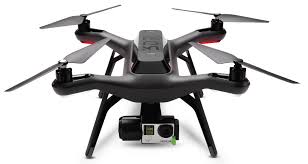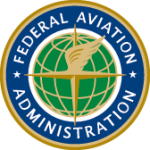 This past year the FAA (Federal Aeronautical Administration) set up and began testing a new service, LAANC. For folks who wanted to fly their drones (quadcopters, or other Unmanned Aircraft Systems, in the parlance of the FAA), the previous waiver process was tedious at best, often taking eight weeks or more to receive any information about whether you had received approval for a flight within the restricted airspace surrounding major airports.
This past year the FAA (Federal Aeronautical Administration) set up and began testing a new service, LAANC. For folks who wanted to fly their drones (quadcopters, or other Unmanned Aircraft Systems, in the parlance of the FAA), the previous waiver process was tedious at best, often taking eight weeks or more to receive any information about whether you had received approval for a flight within the restricted airspace surrounding major airports.
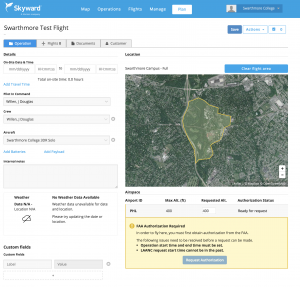 Rather than the former tedious process, I now use a free service from Skyward, one of the 14 companies selected by the FAA to process flight requests for our flights here at Swarthmore. Fortunately, Skyward and the Philadelphia area were among the first to have this service in place. In planning a flight, I log into the system, select my flight area, time and date for my flight, identify the Remote Pilot in Command (I’ve preloaded my license information), and any crew members, and then apply for approval. I usually hear back within just a few seconds of submitting the request!
Rather than the former tedious process, I now use a free service from Skyward, one of the 14 companies selected by the FAA to process flight requests for our flights here at Swarthmore. Fortunately, Skyward and the Philadelphia area were among the first to have this service in place. In planning a flight, I log into the system, select my flight area, time and date for my flight, identify the Remote Pilot in Command (I’ve preloaded my license information), and any crew members, and then apply for approval. I usually hear back within just a few seconds of submitting the request!
At Swarthmore, we’re well within the Class B (Bravo) airspace around Philadelphia International Airport (PHL), so even if you had received approval from the campus authorities for a flight, you would still need to wait those 8 weeks at a minimum, to get approval from the FAA / Philadelphia Air Traffic Control. This new service reflects a partnership between the FAA and some carefully selected companies to streamline and automatize the process. What took eight weeks in the Spring of 2018, now can take mere seconds!
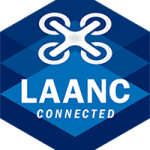 The Low Altitude Authorization & Notification Capability (LAANC), a collaboration between FAA and Industry directly supports UAS integration into the airspace that the FAA controls. With LAANC, the FAA allows licensed Part 107 remote pilots to gain fast access to U.S. controlled airspace in just seconds. It provides access to controlled airspace near airports through near real-time processing of airspace authorizations below pre-approved altitudes in controlled airspace.
The Low Altitude Authorization & Notification Capability (LAANC), a collaboration between FAA and Industry directly supports UAS integration into the airspace that the FAA controls. With LAANC, the FAA allows licensed Part 107 remote pilots to gain fast access to U.S. controlled airspace in just seconds. It provides access to controlled airspace near airports through near real-time processing of airspace authorizations below pre-approved altitudes in controlled airspace. 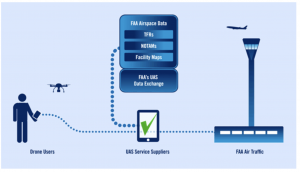 LAANC is based on the FAA UAS Data Exchange, an innovative, collaborative approach between government and private industry facilitating the sharing of airspace data between the two parties. Rather than relying on a human to approve a flight plan, LAANC automates the application and approval process for airspace authorizations. Through automated applications developed by an FAA Approved UAS Service Suppliers (USS) pilots apply for an airspace authorization. Requests are then checked against multiple airspace data sources in the FAA UAS Data Exchange such as temporary flight restrictions, NOTAMS (Notices to Airmen) and the Unmanned Aircraft System Facility Maps. If approved, pilots receive their authorization in near-real time.
LAANC is based on the FAA UAS Data Exchange, an innovative, collaborative approach between government and private industry facilitating the sharing of airspace data between the two parties. Rather than relying on a human to approve a flight plan, LAANC automates the application and approval process for airspace authorizations. Through automated applications developed by an FAA Approved UAS Service Suppliers (USS) pilots apply for an airspace authorization. Requests are then checked against multiple airspace data sources in the FAA UAS Data Exchange such as temporary flight restrictions, NOTAMS (Notices to Airmen) and the Unmanned Aircraft System Facility Maps. If approved, pilots receive their authorization in near-real time.
More information can be found within the “Drone Zone” on the FAAA web site, specifically in the section on the UAS Data Exchange (LAANC) For the most complete details about how the FAA is handling drones, go to the FAA web site on Unmanned Aircraf Systems.
And that’s not all. Late last year, the Congress passed, and the president signed a comprehensive reform of the myriad laws that control the FAA’s purview over Unmanned Aircraft Systems. The most encouraging part of that change is that there is a specific acknowledgment of College and Universities in promoting, teaching and research with these small unmanned aircraft systems. We’re all waiting for the FAA to come out with final rules in compliance with these new laws, due later this Spring.

